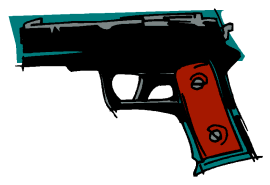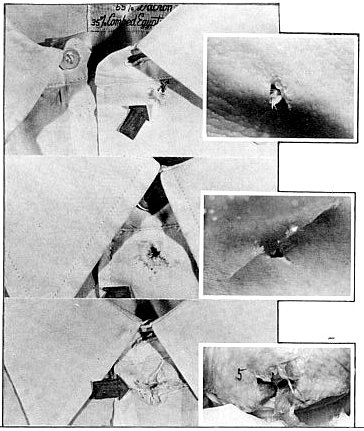

 |
 |
The Small Throat Wound |
Upon learning of the throat wound the day after the autopsy, Humes was forced to revise his autopsy report.Josiah Thompson's Six Seconds in Dallas is a vastly better conspiracy book than Crossfire, but its treatment of the issue is essentially the same:The autopsy doctors determined that the back wound was 4 to 7-millimeters in diameter and the Dallas doctors said the throat wound was 3 to 5-millimeters in diameter. Since the back wound was larger, this would normally suggest that the neck wound was one of entrance and the back wound one of exit — assuming both holes represented the path of a single bullet. (p. 374)
Various descriptions of the small hole in the President's throat were given at Parkland Hospital by the doctors who saw it before a tracheotomy incision erased its outline. . . . [A]ll seemed to agree on the size of the hole. It was small — so small, in fact, that one doctor believed it was too small to be even the entry hole of a high velocity bullet (6H56). Dr. Perry described it over the phone to Commander Humes as between 3 and 5 millimeters in diameter (17H29). This is half the diameter of an ordinary pencil, much too small to be he exit wound of a transiting bullet. (p. 51, emphasis in original)So both Marrs and Thompson repeat the "3 to 5 mm." figure in the notes Commander Humes made when he talked to Dr. Perry the morning after the autopsy.
But the descriptions of the wound in fact varied quite a bit. The following are all the estimates of the size of the wound given by Parkland staff in Warren Commission testimony:
The nature of a wound generally indicates the type of gun that inflicted it. The wounds caused by shotguns are usually easy to identify. As for the wounds caused by rifled weapons, the size of the wound is not always helpful in determining the caliber or type of weapon (pistol, revolver, rifle). In fact, the size of the wound can be misleading (Fig. 8-2). The diameter of the wound may be smaller, greater or equal to the diameter of the bullet. Therefore, one must give a guarded opinion about the caliber of the bullet from the examination of the wound (Fig. 8-3). (p. 84)Here is Figure 8-2:

| The wound caused by the 0.38 caliber bullet is much smaller than the bullet itself. |

| The entrance wound caused by the 0.32 caliber bullet is much smaller than the bullet itself. |
The increase in the area of the striking surface of a bullet at the point of exit due to deformation, yawing or tumbling explains why the exit wounds are usually larger than the entrance wounds. (p. 121, emphasis in original)Then Fatteh goes on to explain an important exception to this rule:
The presence of objects pressing against the skin in the area of exit of the bullet may affect the size of the exit hole. The pressure from such objects limits external stretching of the margins of the perforated skin. Consequently the subsidiary tears are not as extensive as they would otherwise be. The exit hole in such circumstances tends to be small and round with minimal tearing of the margins. (p. 121)Exit of the Bullet Against Pressure
If a bullet exits from the skin without any resistance other than the tissue resistance, an exit hold with subsidiary tears results. . . . If, however, the bullet exits from the skin against pressure from a firm or hard object in contact with the skin, the appearances of the exit wounds are different. . . . If the object in contact with the skin is hard and the bullet exits against considerable resistance from it, the exit wound may not only be round but it may show a rim of abrasion in its margins. Such exit wounds could easily be mistaken for entrance wounds. Exit wounds of this nature may be seen when the victim is lying on the ground or standing against a wall when shot and the exited bullet is stopped by the ground or the wall. They may also be caused when the exited bullet hits a belt, buckle, tough clothing or a similar object in tight contact with the skin. (pp. 124-125).

Lattimer used pork legs, with the bone removed, to simulate Kennedy's neck. Around the pork he fastened a shirt and tie like the one Kennedy was wearing on the day of the assassination. Using a Mannlicher-Carcano rifle and ammunition identical to that used by Oswald, shot through the "neck" at an angle that caused the bullet to exit at the same place, relative to the tie and collar, that the Single Bullet exited Kennedy's neck. The resulting exit wound was very small, approximately ¼ in. in diameter (see top illustration at right).
When he did the same experiment, but shot so the bullet exited a quarter
inch below the border of the collar, the wound was small, but showed stellate
tears at the margins (second illustration). Finally, he removed the
tie from his "victim," and put a bullet through that exited a half inch
below the bottom margin of the collar. The resulting exit wound was
large and jagged — a very typical exit wound (bottom illustration). (Kennedy
and Lincoln, New York: Harcourt Brace Jovanovich, 1980, pp. 234-236.)
(270) The panel considered the appearance of the wound in the anterior neck as initially described and subsequently altered. It is of the opinion that such a wound, uniformly regular in shape and small in size, might be anticipated from an intermediate or even high velocity missile if the tissues through which the missile exited were shored, buttressed or otherwise reinforced by clothing or other external objects that would minimize the outward displacement of the skin and underlying superficial tissue and consequent tearing and distortion of these tissues. . . .The forensics principle the conspiracists are pushing here — exit wounds are bigger than entrance wounds — is not as absurd as the claim that the paraffin test exonerates Oswald, or that the Dallas cops should have tested the rifle found in the Depository to see whether it had been recently fired. But if they had been genuinely trying to determine what happened, rather than seize any opportunity to get their boy Lee off the hook, they could have figured this one out.(271) The panel members agree that the fabric of the shirt and tie and their anatomic relationship to the underlying missile wound might have served as sufficient reinforcement to diminish distortion of the skin. Several panel members are also of the opinion that an unshored exit wound of a missile of comparable size and velocity might be similar if the missile were not misshapen by striking a substantial bone within the body. The panel believes that it would be reasonable for a surgeon not to appreciate or even consider the significance of the clothing in terms of the wound shape produced, especially if the clothing had been removed prior to his initial examination . . . (HSCA Volume 7, p. 95).